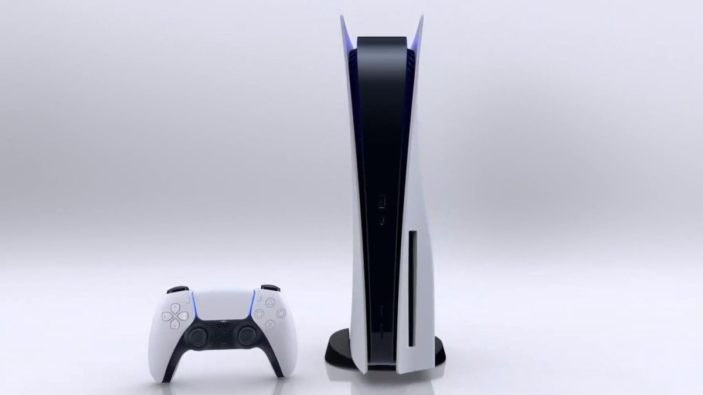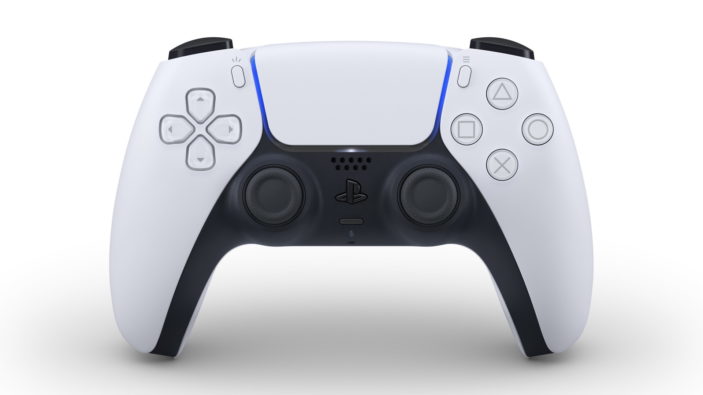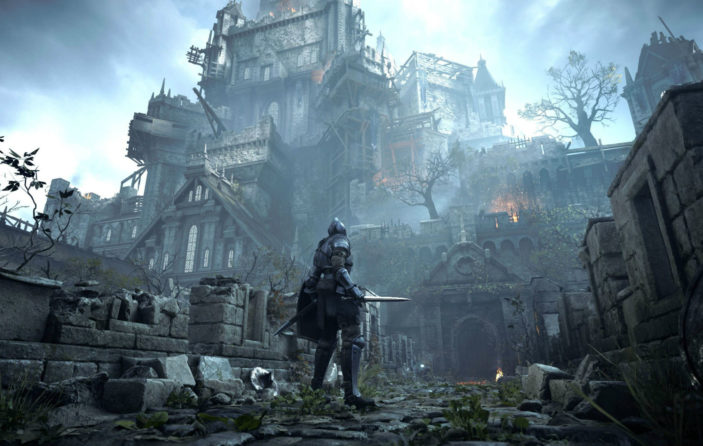
The PlayStation 5 is the direct successor to the most successful video game console of all time. Success has been Sony’s watchword for the past seven years as its popular PlayStation 4 smashed industry records. It seemed that the system could do no wrong. A library of smash-hit first-party titles. A design that still feels relevant sleek today. An install base that was, and remains, the envy of its competitors. The PS4 cemented the name PlayStation as being synonymous with gaming, and now it falls to the PS5 to continue that legacy.

Damn boy, that’s a thicc ass boy
The first thing you’ll notice about the PlayStation 5 is that it is large. Very large. Gigantic, in fact. If it feels like a flex, that’s because that’s exactly what it is. After a generation spent at the top, Sony is feeling pretty good about itself, and so it should. Constructing a monument to its own hubris isn’t the direction I expected Sony to move in, but I can see how it got there.
Statement pieces are rare in the world of home electronics. They’re rarer still in the realm of home theatre. The unspoken rule of home theatre design is that your product should fit neatly into any setup. It should be simple, sleek, and, ideally, a nice, forgettable shade of matte black. Hardware, the thinking goes, shouldn’t call attention to itself. Its job is to blend in, not catch the eye. Your attention should always be on the screen.
Sony said heck all that. Look at this thicc ass boy. Look upon our galaxy-tier chonker and submit your wallet for inspection. We do not build our machine to suit your setup. Your setup will bend to accommodate us. Coming from any other device, this approach would have been met with widespread criticism from the games community. But the PlayStation 5 isn’t any other device.
When assembled vertically on its plastic stand, the unit itself stands (roughly) 40cm high, 26cm wide and about 10cm at its thickest, and weighs in at about 4kg. A pair of matte white wings envelop a glossy black inner chassis, framing its rounded upper edge in what the internet has described as a popped collar. The unit can be placed in either vertical or horizontal position and the plastic stand affixed — with a screw if placed vertically, or snapped into place with a pair of curved teeth for horizontal storage.
This bombastic design makes the console about as unwieldy as it gets if you expect to fit it into an entertainment unit. But Sony doesn’t want you to put it in a cupboard and hide it away. They want PS5 ownership to be a status symbol. They want the unit placed aside the television, where it can be noticed by guests and your good taste applauded. The trouble is that, unless you are an Instagram influencer from Los Angeles, it’s unlikely you own a home with the all-white minimalist aesthetic into which it fits. It’s impossible not to see Sony’s inflated sense of self-importance at work in this design, and you’ll either be very into it or not all.
For my part, I look forward to the arrival of a thinner iteration in 2022.
Under the hood
Whatever your feelings on its external design, what can’t be argued with is the PlayStation 5’s spec sheet. At the time of its arrival in 2020, it is a beast of a machine. Speed is its mandate — faster loading, faster downloads, faster compute cycles — and the faster it can move, the more it can accomplish.
The PlayStation 5’s CPU is a customer AMD Ryzen 8 Core/16 Thread proc running at 3.5GHz (variable frequency). Its GPU is a custom 16GB GDDR AMD Radeon RDNA 2-based graphics engine that moves at up to 2.23 GHz (or 10.3 teraflops). Its 1TB solid state drive actually has about 825gb available by the time you’re finished initial setup. It uses a new 3D audio technology called Tempest 3D Audiotech which promises a far greater level of sound clarity on home console.
It’s rear plate features an HDMI Out port, and four USB ports — one high speed USB Type A port, two super speed USB Type A ports capable of 10Gbps transfers, and a super speed USB Type-C port that can also pull speeds up to 10Gbps. There’s also an ethernet port for those who prefer a wired set up.
For those who are happy to run their machine over WiFi, the inclusion of WiFi 6 is one of the PlayStation 5’s biggest advantages of the Xbox Series X. It does away with the PS4’s notoriously slow download speeds and pushes for tick rates that are far faster than anything seen in previous generations.
So, if you’re the sort of person that doesn’t speak Computer Nerd, what does all that mean? It means the PlayStation 5 is a blindingly fast machine. Every part of it is precision engineered to be as light on its feet as possible. The leap even from PlayStation 4 Pro to the new hardware is almost night and day in terms of its performance. With its performance target of 4K60 with raytraced lighting as a baseline, the coming generation of AAA titles will look exceedingly pretty indeed. While we still don’t have anything that feels truly next-gen to look at just yet, there is plenty to whet the appetite. Demon’s Souls appears to be the graphical showcase for launch, leveraging high res textures and ray-traced lighting to bring its loving restoration of a classic to life.
Demon’s Souls is also where the addition of NVMe m.2 drive’s lightning-fast load times are most keenly felt. In Souls games, having to wait for the game to reload after dying is part of the experience. It lets you take a breath and collect yourself. Because Demon’s Souls loads so quickly, that little moment of zen doesn’t exist anymore. Your run begins anew, right away, and that fundamentally changes the feel of the Souls experience. Whether that change is for better or worse I think will be up to the individual player. I wonder how NVMe will change other games in ways we haven’t really anticipated yet?
The UI
The PlayStation 5 user interface is, if possible, stripped back even further from its already slimline PS4 iteration. The new UI splits the dashboard into two pages — Games and Media. It’s completely clear what goes where. All of your installed games, and all of the built-in apps they use, are found under the Games tab. All your streaming video applications — YouTube, Netflix, Stan, et al — are found under Media. This keeps everything from getting jumbled or confused.
Within the games menu, each game has a submenu of its own that is filled with cards. These cards will help you track all sorts of information about your current game — completion percentage, your most recent trophies, how close you are to completing a particular task. Xbox may have invented the Achievements system Sony later co-opted, but it seems they’ve been the first to iterate meaningfully on it. It’s a system I’m interested to see evolve over time.
Beyond this, the user interface is purpose-built for multiplayer and partying up with friends. In the past, this has been an aspect of console UI that has proven difficult for designers to get around. There were many solutions, some more obvious than others, but none felt as simple as the process should. Here, at last, the PlayStation 5 seems to have cracked the code. Not only can I party up with ease, I can have friends watch my gameplay in real-time and interact before jumping in for multiplayer with them. Great stuff.

The controller
I have a long history of not loving PlayStation controllers. After many years of trying to puzzle this out, the conclusion I’ve reached is that they simply aren’t for me. I don’t love the segmented D-Pad, or the opposed placement of the control sticks, or the way the silhouette of the Dual Shock sits in my hands. From the stick-less PS1 era right through to the Dual Shock 4, I’ve never quite vibed with Sony’s approach to controller design. It felt like Sony cared more about the controller’s “iconic” shape than it did its purpose as an input device or the level of comfort it could offer.
The DualSense controller is the first time I’ve ever picked up a new PlayStation controller and thought “Oh yeah, I love this.”
DualSense is a substantial departure from the norm for Sony. It retains only traces of the DualShock silhouette, moving instead towards something more akin to Xbox’s more universally loved design. It’s a more broad-shouldered design than the DualShock 4, taller and wider so that your index fingers sit more comfortably on triggers. The grips on each side fit comfortably in the palm, allowing your thumbs to rest more naturally on the sticks. The sticks themselves are spaced the same distance apart as on the DS4, and the thumb rests are slightly smaller.
Similarly, face buttons like the D-Pad and the X, O, Square and Triangle buttons retain their traditional spacing. The D-Pad has been lowered slightly to keep the thumb from grazing it too much on diagonal transfers, a change that fighting game enthusiasts will appreciate.
DualSense isn’t without its own new features. Among them, an inbuilt microphone that lets you chat to your friends without a headset. Their voices are played back through the controller speaker, letting you feel a little like they’re in the room with you. The triggers at the rear of the controller are capacitive, meaning developers can determine the amount of resistance they have when pulled. If something is heavy, the trigger might be hard to pull. If you’re, for instance, pulling a rope slack — loose and then tight — the trigger might move freely to a point and then become quite stiff. It’s a small thing but in the hands of attentive developers, it introduces a great new interactive layer.
The star feature, however, is the haptic feedback. The controller is called the DualSense because of its complex force feedback system that allows it to translate fine details through controller rumble. Astro’s Playroom (which we’ll talk about again in a moment) is the showroom for this functionality. It can simulate the broad rattle of huge explosions right down to the subtle tap-tap-tap of individual raindrops. The tech is striking and, when deployed correctly, adds a genuine layer of immersion. But of the games available at launch, I’ve only noticed a couple that take any meaningful advantage of it. The aforementioned Astro’s Playroom is one. Demon’s Souls is the other, and I barely noticed it was using it at all. I’m curious to see if other devs start to use this haptic feature more regularly. I hope they do. For now, it has the makings of a classic, whizz-bang, launch window gimmick. Let us not forget the PS3’s ill-fated Sixaxis.

The games
The PlayStation 5 launch window titles are a little more robust than that of its competitor, the Xbox Series X. Arriving at launch are a slew of exclusives, the biggest of which are Spider-Man: Miles Morales, Demon’s Souls (pictured), Sackboy: A Big Adventure, GodFall, and Bugsnax.
For the casual player, Miles Morales is the big and obvious draw. Picking up where the 2018 smash hit left off, Miles Morales switches POV characters to the new spider on the block. Playing in Fidelity mode locks the game to 30 frames per second, but allows it to run in 4K HDR with ray-traced lighting and reflections, and upgraded weather effects. The result is a game that looks utterly, utterly beautiful. You can always switch back to Performance mode if you prefer 4K res with 60 frames, but it turns off all those graphical bells and whistles.
Demon’s Souls is a treat for the hardcore, a remake of a beloved older chapter in the From Software library by Bluepoint (Shadow of the Colossus). Beautiful in its visuals and utterly punishing in its difficulty, the From Soft faithful know what they’re up against already. Sackboy is a traditional platformer full of charm and joy that recalls the best of the LittleBigPlanet franchise while walking back a few of its more creator-centric aspects. GodFall wants to do the persistent-world, Destiny-style online shooter thing with more of a Diablo-like focus on melee combat. It doesn’t always succeed, but it certainly looks very pretty, making it the obligatory Beautiful But Vapid launch title. And then there’s Bugsnax, this month’s free PS5 title on PlayStation Plus. Weird, wonderful, and best sampled without knowing much about it. Give it a try.
The PlayStation 5 is also the unlikely resurrector of the pack-in title. Astro’s Playroom is a short, sweet little game designed to familiarise you with all the PS5’s new hardware and features. Each of its levels showcases one of the system’s best features — graphics, processing power, its flashy new controller — and rewards you with dopamine hit after dopamine hit of PlayStation nostalgia. It’s a fun, sparkly little way to kill a few hours, and the perfect game to throw at the kids should they decide they’d like a turn on the new hardware.
There’s more on the horizon for PS5 as well, with Arkane’s DeathLoop and a brand new Gran Turismo from Polyphony Digital on the way.
The big draw for PlayStation owners, beyond the graphical promise of the machine, is that of its first-party studios. Sony has built a reputation for being the HBO of video games, the home of high budget, high quality content you can’t play anywhere else. Miles Morales gives us a little taste of that at launch, but the heavy hitters like Santa Monica Studio’s God of War: Ragnarok and Guerilla Games’ Horizon: Forbidden West, sit tantalisingly in the distance.
https://www.youtube.com/watch?v=t12x7k_oecc
Final thoughts
If its true that the era of what we consider “traditional” video game consoles is ending, the PlayStation 5 marks the beginning of a bold new age. It’s fast, powerful, and full of promise. It’s learned valuable lessons from its predecessor and executed on those lessons to its benefit. Far from resting on its laurels, PlayStation has made huge moves to keep its world-beating system ahead of the competition. We look forward to watching it evolve in the coming years.
Review conducted with a retail unit provided by the manufacturer.
